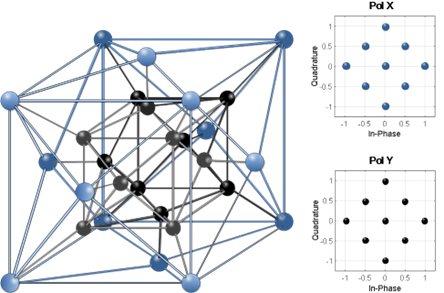Robust multidimensional optical modulation based on hybrid subcarrier/amplitude/phase/dual polarization for wavelength-division multiplexing systems
Main Article Content
Abstract
Here, we propose a novel scheme based on advanced digital modulation techniques in optical communications to achieve a single-channel transmission rate above 100 Gb/s. We utilize a hybrid scheme amplitude/phase/frequency/dual polarization, combined with multidimensional dual lattice and a low-density parity-check-coded modulation. The Stokes parameters are applied to the proposed scheme to map the four-dimensional classical polarization IX, QX, IY, and QY in a three-dimensional space. In addition, the packing theory is applied to the bit interleaving process in the proposed system. Three wavelengths are packaged before being transmitted over a wavelength-division multiplexing optical channel. This modulation process uses symmetrical geometric shapes, such as a hypercube or a polyhedron, based on the molecular links theory using a grouping of 12 and 13/15 bits for the cubic and spherical lattices, respectively. The proposed technique is evaluated in the context of long-distance communications over distances up to 100km. The bit error rate (BER) results showed that the optical signal-to-noise ratio was approximately 4dB over 50km. In addition, the power spectral efficiency was found to be three lambdas, which is considered a good performance considering the effects of distance and the non-linear effects influencing the number of lambdas. Also, we use an optical time-division multiplexing scheme (OTDM) to achieve a transmission rate beyond 1Tbit/s, where the speed effect is evaluated, considering that the power spectral efficiency is degraded.
Downloads
Article Details
Section

This work is licensed under a Creative Commons Attribution 4.0 International License.
Authors who publish in this journal agree to the following terms: Authors retain the copyright and guarantee the journal the right to be the first publication of the work, as well as, licensed under a Creative Commons Attribution License that allows others share the work with an acknowledgment of the authorship of the work and the initial publication in this journal. Authors may separately establish additional agreements for the non-exclusive distribution of the version of the work published in the journal (for example, placing it in an institutional repository or publishing it in a book), with acknowledgment of its initial publication in this journal. Authors are allowed and encouraged to disseminate their work electronically (for example, in institutional repositories or on their own website) before and during the submission process, as it may lead to productive exchanges as well as further citation earliest and oldest of published works.

